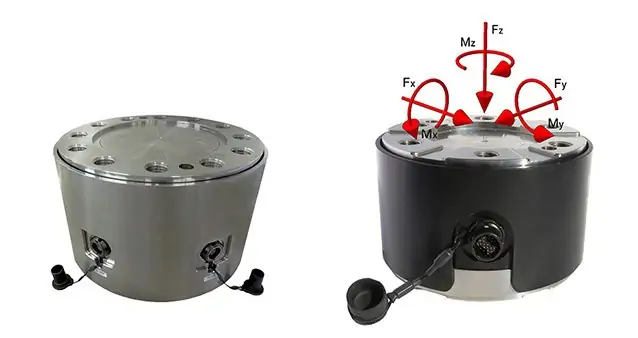Fischer Connectors has released the following article explaining how its MiniMax Series of compact connectors has been integrated into strain gauge sensors used in robotics and other applications. These sensors monitor the axial forces and torques acting on systems in order to ensure safe and reliable operation.
The forces and torques acting on machines and systems, especially on the axes, need to be monitored constantly. This is the only way to ensure safe and precise operation. One proven methodology for obtaining reliable results is strain gauge technology. However, since the sensors are very small, the connection technology also has to be suitably minimized. At the same time, data transmission must remain stable even when there are vibrations. One manufacturer of these sensors, ME-Meßsysteme GmbH from Hennigsdorf in Brandenburg, Germany, relies on the compact, robust connectors in the Fischer MiniMax Series.
Reliable measurement data are crucial for ensuring that systems and machines in robotics, medical technology or the automotive industry operate safely and efficiently. Data showing which forces and torques are acting on axes are particularly important. For this purpose, ME-Meßsysteme’s K6D sensors rely on a combination of six independent strain gauge sensors. These are equipped with strain gauges in full-bridge configuration. Based on the six sensor signals, the forces in the three axes of the space as well as the three moments around these axes are precisely calculated according to a calculation rule.
In recent years, requirements on precision in measurements and sensors’ reaction times have increased continuously. Since analog technologies offer a huge speed advantage when converting signals, these are usually relied on in practice. In addition to their high precision, they can also achieve very short response times. This is essential, particularly for fast machine processes and robots.
The sensors have to transmit the analog and sensitive small signals from the process to the control computer faster and faster. This is a major challenge, especially for sensors with small mechanical proportions and several integrated dimensions, and in particular for the connector between the sensor unit and the transmission. The junction between the connector and sensor is the most critical in the entire system. Machine vibration or movement at the solder joints can cause connectors to lose the connection, resulting in errors in measurements and machine downtime to fix them.
The connection situation is particularly critical for force-torque sensors like ME-Meßsysteme’s K6D sensors. A total of 24 contacts (6×4) are required to connect the strain gauges. Due to increasing miniaturization, the connectors have to be very small yet powerful. Until now, reliable transmission of strain gauge signals has only been possible using one connector per strain gauge. Therefore, the challenge for force-torque sensors was to integrate all 24 contacts into a single connector. At the same time, the connectors’ weight had to be reduced to guarantee maximal contact reliability even with high accelerations and vibrations.
Conventional connectors do not generally meet this application’s particular requirements, being either prone to vibration, not waterproof, too heavy or complex to assemble. The Fischer MiniMax Series connectors solve all these problems.
Challenges and opportunities
The powerful and robust MP11 connectors in the Fischer MiniMax Series are used in the 6-axis force sensors. What makes them special is that, during cable assembly, the individual strands are encapsulated several times and the cable sheath is overmolded using special molding technologies to prevent resistance changes from occurring during vibrations and cable movements. The cable from the sensor to the amplifier must demonstrate stable resistance behavior under thermal and mechanical stress, which is usually achieved through a special drag chain-compatible cable design and supported by the molding process on the connector. This combination results in very high vibration resistance.
Connecting and disconnecting the interconnect cable is equally safe and robust with this connectivity system. This saves service technicians a considerable amount of time when assembling, installing, servicing or calibrating the system. The MiniMax connectors are also an ideal choice for this application due to their low weight, very compact dimensions, and resistance to liquids up to IP68.
Since ME-Meßsysteme also has even smaller multiple sensors in its portfolio, including the K3R 3-axis force-torque sensor and the K3D 3-axis force sensor, the company also needed a solution for these products with the same requirements. The K3R and K3D measure forces on the X, Y and Z axes. For this, 12 connections are required, namely four per strain gauge. Since this application is even smaller than the K6D, a special solution was needed here too.
Fischer Connectors was once again able to help with its MiniMax connectors. For such small and special applications, the MiniMax in size 06 with 12 contacts and a reduced diameter offers the same benefits as in the K6D family for all three measuring channels. Even the smallest connectors in the Fischer Minimax Series enable extremely robust signal transmission, with not even machine vibrations influencing the transmission resistances or the resultant signal stability.
Dr. Holger Kabelitz, Managing Director of ME-Meßsysteme GmbH, commented: “In the past, we’d tested various connectors from different manufacturers, but we’d always came up against the same problems: The connectors were either prone to vibration, not waterproof, too heavy or complicated to assemble. All in all, they didn’t meet our requirements nor those of the application. When we came across the Fischer MiniMax Series connectors, we’d found our solution. The MiniMax connectors are compelling, particularly due to their low weight, very compact dimensions and resistance to liquids in compliance with IP68.”











